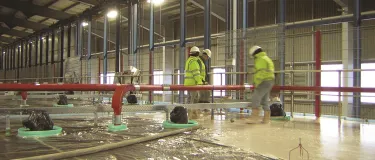An essential guide to screed

Screed plays a vital and often underappreciated role in a great number of construction projects, particularly in the preparation and finishing of floors.
In this guide, we’ll be taking a look at this fundamental building material, highlighting its critical role in creating durable, functional and aesthetically pleasing floors in various types of domestic and commercial buildings. You’ll find out what screed is, its components, the different types of screed available and the advantages of choosing screed.
Contents
- What is screed?
- What is screed made of?
- What is Screed Used For?
- Residential Applications
- Commercial Applications
- Versatility and Suitability
- The Different Types of Screed
- Flowing screeds (cementitious and anhydrite)
- Semi-dry screed
- Bonded screed
- Unbonded screed
- What is the difference between screed and traditional concrete?
- Why use screed instead of traditional concrete?
- Conclusion
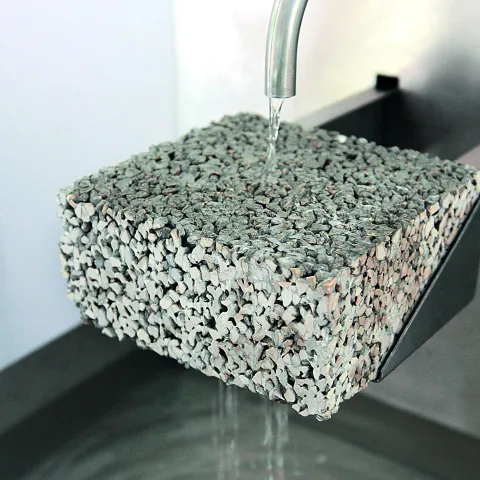
Read more about our branded concrete mixes which are accredited BES 60001
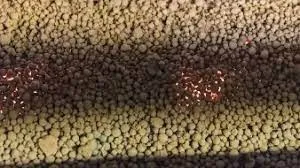
What is screed?
Screed is a crucial component in construction, especially when it comes to preparing floors. It is laid over a concrete subfloor and plays a significant role in ensuring that the final floor surface is even and smooth. The primary function of screed is to provide a level base for laying flooring materials such as tiles, carpet, or wood flooring.
This layer not only aids in achieving a visually appealing finish but also contributes to the floor's structural integrity. By creating a flat and stable surface, screed helps prevent potential issues related to uneven flooring, such as gaps or misalignments in the flooring material. It's particularly useful in environments where a level and uniform surface is essential for safety and functionality, like in residential homes, commercial buildings, and industrial spaces.
In essence, screed acts as an intermediary layer that bridges the gap between the raw structural components (like concrete subfloors) and the final decorative elements of a floor. Its application is a testament to the meticulous nature of construction work, where every layer and component plays a pivotal role in the overall quality and durability of the building.
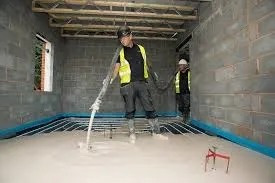
What is screed MADE OF?
Screed is composed of a carefully balanced mixture of cement, sand, and water, each contributing to its final properties. One of the fundamental components of screed is cement, which acts as the binder, holding the mixture together and providing structural strength once it sets.
Sand, typically sharp sand, is mixed with the cement, lending screed its characteristic smooth texture and further contributing to its stability and durability. The proportion of sand to cement can vary, but it generally follows a ratio to ensure the right balance of strength and workability.
Water is the third key component, necessary to activate the cement and enable it to bind the sand particles together. The amount of water added is crucial to the quality of the screed; an optimal balance is needed to achieve a mixture that is workable yet sets with adequate strength. The typical water-to-cement ratio in screed is carefully measured to ensure this balance, with variations adjusted based on specific requirements of the screed application.
In some formulations of screed, additional materials or additives might be included to enhance certain characteristics. These can range from quick-drying agents to improve the setting time, to specific compounds designed to augment thermal conductivity in screeds used with underfloor heating systems.
The composition of screed, while seemingly simple, is a testament to the precision required in construction materials. It highlights how each ingredient's proportion directly impacts the screed's performance in terms of durability, setting time and suitability for various applications.
What is it used for?
Screed is an adaptable material used in both residential and commercial construction projects for a variety of applications, each benefiting from its unique properties.
Residential applications
In homes, screed is commonly used in conjunction with underfloor heating systems. Its excellent thermal conductivity allows for efficient heat distribution, ensuring that the floor heats evenly and effectively. This makes screed an ideal choice for homeowners seeking a comfortable and energy-efficient heating solution.
Additionally, screed's level and smooth surface is perfect for polished indoor floors, which are becoming increasingly popular in modern homes. This type of flooring requires a perfectly flat base to achieve the desired aesthetic and functional quality, and screed provides just that.
Commercial applications
In commercial settings, such as warehouses or retail spaces, screed is valued for its durability and the level surface it provides. Warehouses, in particular, benefit from screed flooring due to the heavy traffic and machinery that operate within them.
The screed layer ensures a robust and even surface, capable of withstanding the wear and tear of daily operations, while also providing a safe working environment. In retail spaces, screed can be used under various types of flooring finishes, supporting the aesthetic appeal and functionality of the commercial area.
Versatility and suitability
Screed's suitability across different applications lies in its versatility. It can be tailored in terms of thickness and composition to suit specific needs, such as load-bearing capacity in industrial settings or thermal efficiency in residential environments.
This adaptability, combined with its inherent properties of providing a level, smooth surface, makes screed a go-to material for a wide range of flooring applications. Whether in a home, warehouse, or retail space, screed plays a vital role in ensuring the longevity, safety, and aesthetic appeal of the floor.
The different types of screed
Each type of screed offers unique benefits and is suited to different applications, depending on factors like the construction type, required strength and environmental conditions. Selecting the right type of screed is essential for ensuring the longevity, functionality and aesthetics of the flooring.
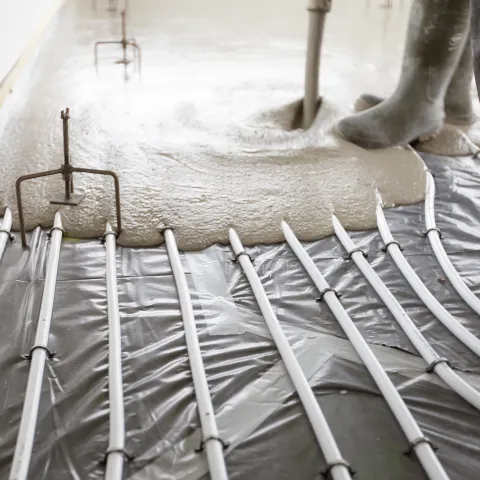
Flowing screeds
Flowing (Cementitious)
Cementitious flowing screeds, such as Cemfloor, offer a modern solution for floor levelling and finishing. These screeds are delivered in truck mixers and placed in-situ by pumping, making them easy to install. Their self-compacting nature ensures a smooth finish without the need for manual levelling. Designed for use over thermal or acoustic insulation, cementitious flowing screeds enhance efficiency by eliminating drafts, preventing pipes from freezing, and creating an effective moisture barrier. This makes them particularly suitable for buildings with underfloor heating systems.
Flowing (Anhydrite)
Anhydrite flowing screeds, like Highflow Rapide, are composed of high-quality Gyspol anhydrite, specially graded sands, and selected additives. They are known for their rapid installation, strength gain, and setting, significantly reducing construction times. This type of screed is self-compacting and high-performing, with the added advantage of being self-curing, eliminating the need for a membrane post-installation. Its versatility makes it ideal for various construction types, including traditional masonry, lightweight steel frame, timber frame, and high-strength structures.
Semi Dry Screed
Semi-dry screeds, exemplified by Screedform, are cement-based and produced under controlled factory conditions. This production method allows for a range of strength grades and reduced drying times. Suitable for placement both above and below the damp proof course level, semi-dry screeds are versatile for bonded, unbonded, or monolithic applications. They are ideal for residential, commercial, and public buildings, and especially advantageous in areas prone to wet conditions such as bathrooms and swimming pool surrounds.
Bonded screed
Bonded screed is directly applied to a concrete base, creating a strong bond between the screed and the concrete. This bond is achieved using a bonding agent or primer. The strength of this bond allows for a thinner screed layer, typically between 25mm and 40mm. However, due to the rigidity of the bond, there is a higher risk of cracking.
Unbonded screed
Unbonded screed is not directly applied to the concrete base. A barrier, usually a layer of plastic sheeting, is laid between the concrete and the screed to prevent moisture transfer. The typical thickness for unbonded screed ranges from 50mm to 75mm. This method offers more flexibility compared to bonded screed, which helps in reducing the risk of cracking.
What is the difference between screed and concrete?
Understanding the difference between screed and concrete is important, as each serves a distinct purpose and possesses unique characteristics.
Composition and texture
The primary difference lies in their composition and texture. Concrete, a well-known construction material, is made from a mixture of cement, water, and aggregates like gravel and sand. This composition gives concrete its high strength and durability, making it ideal for structural purposes such as foundations, walls, and support beams. Concrete has a coarser texture due to the larger aggregates used in its mix.
Screed, on the other hand, is a finer blend, predominantly composed of cement and sand, with a higher sand-to-cement ratio than concrete. The absence of larger aggregates like gravel results in a smoother and more level surface. This finer texture is what makes screed suitable for finishing the top layer of a floor.
Application and purpose
Concrete is the go-to choice for structural and load-bearing elements due to its robustness and capability to withstand substantial weight and environmental stress. It forms the core framework of buildings and infrastructures, providing the necessary strength and stability.
Screed, in contrast, is used primarily for aesthetic and functional finishing of floors. Its application is generally limited to the upper layer of a floor structure, where it provides a level and smooth surface suitable for the final floor finish, such as tiles, wood flooring, or carpet. Screed can also enhance the floor's properties, such as thermal and acoustic insulation, especially when used with underfloor heating systems.
Suitability and performance
The choice between screed and concrete depends on the requirements of the construction project. While concrete is essential for its structural integrity, screed is indispensable for its role in providing a perfectly flat and smooth surface, crucial for the final floor finishes. Both materials, though different in composition and purpose, are essential in the construction process, each contributing to the overall quality and functionality of the built environment.
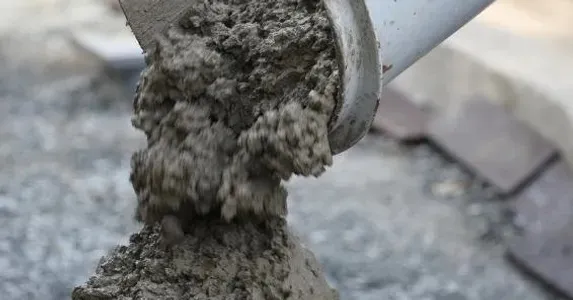
Why use screed instead of concrete?
Choosing between screed and concrete depends on the specific requirements of a construction project. While concrete is indispensable for its structural strength, there are several reasons why screed is often preferred over concrete for certain applications, particularly flooring.
Achieving a smooth and level surface
Screed is specifically designed to create a smooth and level surface. Its finer texture, resulting from the higher sand-to-cement ratio without the coarse aggregates found in concrete, makes it the ideal material for finishing floors. This smoothness is essential for laying floor coverings such as tiles, carpets, or wood flooring, ensuring they fit perfectly and are aesthetically pleasing.
Enhanced compatibility with floor finishes
Floor finishes require a flat and even base to be properly installed and to perform well. Screed provides this necessary level base, ensuring that the final flooring is not only visually appealing but also functionally sound. This compatibility is particularly important for delicate finishes that could be damaged by an uneven surface.
Better thermal and acoustic insulation
In cases where thermal or acoustic insulation is a priority, such as in residential buildings with underfloor heating systems, screed is the preferred choice. Its composition allows for better heat distribution and insulation, making the environment more comfortable and energy-efficient. Similarly, its density and consistency can aid in soundproofing, reducing noise transmission between floors.
Reduced thickness and weight
Screed can be applied in a thinner layer compared to concrete, which is beneficial in reducing the overall weight and volume of material used. This aspect is crucial in renovations or projects where weight is a concern, such as in upper floors of buildings. A thinner layer of screed can still provide a level surface without adding excessive load to the structure.
Flexibility in application
Screed offers greater flexibility in application methods, with options like bonded, unbonded, or floating screeds tailored to different needs. This adaptability allows for customised solutions depending on the specifics of the project, such as the type of subfloor, the presence of insulation or heating systems, and the desired finish.
In conclusion, while concrete is unmatched in providing structural strength, screed is the material of choice for achieving a high-quality, functional, and aesthetically pleasing floor finish. Its unique properties make it indispensable in situations where a smooth, level, and compatible surface is required for the final floor covering.
Faster construction
With options like flowing screed, construction times can be significantly reduced. These screeds are easier and quicker to install compared to traditional methods, helping to speed up the construction process without compromising on quality.
Conclusion
We’ve shown that screed plays a key role in ensuring a smooth, level surface for the proper installation of floor finishes, contributing to both the aesthetic and functional aspects of a building.
However, the importance of screed extends beyond just the surface level. Bridging the gap between the raw structural foundation and final touches, it enhances the structural integrity of floors, improves thermal and acoustic insulation and can even speed up the construction processes.
As construction techniques continue to evolve, the role of screed remains constant, quietly ensuring that the foundations we walk on are safe and sound, whether in a home, a bustling commercial space or an industrial setting.
Frequently Asked Questions
Screed is a thin layer of material that is poured or laid over a concrete base to create a
smooth and level surface. It can be left bare e.g. for warehouse or industrial flooring where
scuff marks are to be expected, but is more commonly covered with a decorative final floor
such as carpet, tiling, laminate, vinyl, stone or wood.
Floating screed is one the three main types of screed and is generally laid on a layer of
insulation, unbonded from the concrete base. Floating screed is used for acoustic or thermal
insulation, or in buildings with underfloor heating.
Latex screed is a self-levelling compound that includes resin. This ensures a smooth,
consistent and level finish on any surface, so is ideal for patching up a bad job! Latex screed
is rapid drying and can be applied to small or large areas. Latex screed does not contain
protein, meaning it is excellent for high safety/hygiene locations such as hospitals, surgeries
and medical centres.
Liquid, or flow, screed is a fast drying, easy-to-apply screed that is suitable for almost all
building projects. Self-levelling and self-compacting, liquid screeds are pumped into place,
allowing for a much thinner coating to match any depth.





